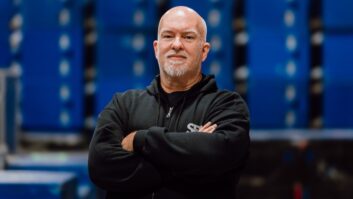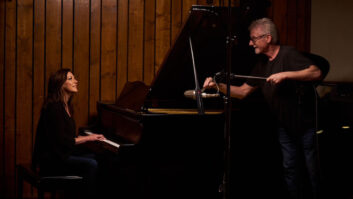New York’s gilded midtown entertainment palace, Radio City Music Hall, narrowly escaped the wrecker’s ball in the late 1970s during the last days of disco. However, unlike several other New York architectural landmarks, Radio City survived and prospered; during the following two decades the 5,874-seat room has again become a “must play” venue for top music entertainers, and it hosts a wide range of musical and nonmusical events.
Early this year, Radio City Music Hall closed temporarily for a long-needed restoration. When it reopens, in six months or so, Radio City will join the splendidly restored Grand Central Station and the enormous Main Reading Room of the New York Public Library (restorations of both were completed last fall) in a trifecta of cavernous, breathtaking spaces from bygone eras.
One of the last events staged at Radio City before it closed for renovation featured the enticing combination of Tony Bennett singing with the Count Basie Orchestra, plus young neo-swing act Squirrel Nut Zippers. The event’s producers took every advantage of the production and, in keeping with the big room’s swing-era heritage, the audience was greeted by several young couples who Lindy-hopped down the aisles and up onto the stage. And the show never stopped once it started. From the time the Squirrel Nut Zippers and all their gear rose from beneath the stage on the massive, elevated front area at 8 o’clock sharp until Bennett’s final encore, there wasn’t a single break.
As soon as the Squirrel Nut Zippers finished their unusual hybrid of ragtime and swing, they dropped below stage level via the elevator. “Radio City is one of the largest indoor venues, short of an arena, in the world,” observes Tony Bennett’s FOH engineer, Tom Young. “The stage is 100 feet wide by 60 feet deep, with 40 feet of offstage area. Imagine having the opportunity to put an entire act on an elevator and then wheel a legendary big band out to center stage, all ready to go! That doesn’t happen at many other places.”
A curtain rose and the Count Basie Orchestra rolled out on Radio City’s self-propelled band car, essentially a mobile elevated bandstand that can travel the entire depth of the stage. (In a nod to contemporary production demands, the band car has been fitted with a 50-pair audio snake by house audio engineer Eddie Santini.) The 17-piece orchestra immediately launched into their first number, barely waiting for the last notes of the Zippers to fade. After a too-short, three-song set, the Basie band’s solo turn was over. The band car then rolled farther downstage and the Basie rhythm section gave way to the Ralph Sharon quartet; Sharon is Bennett’s longtime music director and discovered Bennett’s signature hit I Left My Heart in San Francisco. The entire crack Basie horn section stayed put. Seconds later the star of the show walked onstage, straight from singing the national anthem at the opening game of the World Series at Yankee Stadium. The genial, ageless Tony Bennett thrilled the crowd with a long, beautifully paced set that combined hits with superb lesser-known material.
ACOUSTIC TREATMENTSThe magnificent hall of Radio City, with its gilded sunrise proscenium and triple balconies, presents several challenges to the conscientious audio engineer. Above the last balcony is a large back wall that was originally an absorbent surface but is now quite reflective, and the front surfaces of the three balconies are also reflective. “Those surfaces present problems, but the cost of putting up acoustic treatment for one show would be prohibitive,” explains Young, who took over mixing Bennett’s show four years ago (from Mix Sound Reinforcement editor Mark Frink) shortly after the retirement of his previous client, Frank Sinatra. “If we were going in for a month you would want to bring in some material to absorb the energy.”
The large back wall and balcony fronts were, in fact, originally built as absorbent surfaces, according to acoustical consultant Sam Berkow. Berkow’s Manhattan-based company, SIA Acoustics, conducted an acoustical evaluation of Radio City Music Hall in 1994. “Radio City is a beautiful room with wonderful staging opportunities,” he says. “However, if you are onstage or sitting in the first orchestra section, you’re likely to hear a slap-back from that large wall and from the fronts of the three balconies.” Those surfaces were originally fabric-covered wooden frames over cinder block walls with acoustic damping material placed between. “The hall was built in the early 1930s, and since then the absorbent material decayed,” says Berkow. “The fabric covering was later coated with fireproofing, which rendered the surface more reflective.” Overall, however, Berkow (who built a 3-D acoustical computer model of the room) says that Radio City is “not all that reverberant. The scalloped edges of the proscenium arch and the light slots built into the ceiling make it quite dry for so large a room.”
Young carefully selected a speaker system to help keep the reflections down. “The key to Radio City is really in the hang of the P.A.,” he explains, “to direct energy into the audience and not at the walls. That is one reason I used the Turbosound Floodlight speakers which, despite the name, are a higher-Q box without wide dispersion. My basic approach was to use a large center speaker cluster to keep the energy off the walls. If I’d gone for a larger left and right setup, the problems would have been greater.” Young flew a four-by-four center cluster of THL 760 Floodlights as well as left and right clusters of two cabinets wide and four deep. Eight Turbosound TSW 721 bass cabinets were ground-stacked to each side, with three more Floodlights perched on top.
Fortunately, Young’s crew was able to rig the cabinets the day before, an expensive luxury considering the show was a one-nighter. “If I’d had to hang the boxes the day of the show, we wouldn’t have done as well as we did,” Young says. The trick isn’t all in speaker placement, however. “I also balanced the energy so the room doesn’t get overly excited, and that is easier to do with acoustic acts,” Young says.
TIGHT FEEDBACK REJECTIONOther than the P.A., Young’s basic gear was the same as what he uses for Bennett’s other shows, most of which take place in 2,000 to 3,000-seat theaters. Tony Bennett has used a Sennheiser SKM 5000 wireless condenser mic for the past three years, since upgrading from the ubiquitous SM-58. “The SKM 5000’s super-cardioid pattern capsule has really tight feedback rejection-he’s often a foot or more away from the capsule,” says Young. “As you get close, the tonality doesn’t change all that much. And when he’s two feet from the mic, it sounds much like it does when he’s closer. You pull most vocal mics two feet away and they’re just gone.”
Miking the 17-piece Basie band was a challenge. The Basie horn section uses a classic big band setup of three rows, with the reeds in front and the trumpets behind the ‘bones; Young says that they’ve been working that way forever and aren’t comfortable moving things around, but the setup was so tight there was no room for mic stands. Eighteen-inch goosenecks clamped to each music stand got the mics in the proper placement and kept them low-profile.
The reeds got AKG 414s, the trumpets and trombones Sennheiser 421s. “I try to choose mics that will give a good natural definition of the instrument without much EQ,” Young notes. “The 414 is especially good for reeds, be it a flute or sax, because the pattern is switchable to a tight cardioid.”
Young’s outboard effects are minimal. “I use a Summit Tube Compressor to add some warmth to Tony’s sound,” he explains. “I also use a BSS 901 dynamic equalizer on Tony’s vocal. Every singer has something in their range which is excited a little bit more than something else. Rather than take that out of the house EQ, you can use this unit to frequency compress it when they hit it past a certain threshold.” Young eschews gates. “Both Tony’s quartet and the Basie band are jazz bands, and with the wide range of dynamics they use, sometimes going down to just brushes, you can’t really be closing off mics. I use compression on the bass, kick, snare and guitar just to cover peaks, with a dbx 903.”
Whereas the Squirrel Nut Zippers used a Yamaha PM 3000 along with a Ramsa WRS 840 monitor console offstage left, Young ran Bennett’s monitors from his front-of-house PM 4000. Bennett’s onstage monitors were arranged in a slightly unusual configuration, which Young developed during his 13 years working for Sinatra. “Tony is used to hearing the front-of-house P.A. and the room,” he points out. “To make singers like Tony Bennett comfortable you really have to simulate a concert hall atmosphere onstage so it marries very well with the house.” To achieve this, Young flies four Turbosound side-fills upstage and downstage, so the sound is all around the singer-the only signal in the sidefills is vocal. Young also adds minimal monitoring for the musicians. “It’s the idea of sound reinforcement in its truest sense-I start acoustically and then work from there,” explains Young. “If there is something the musicians can’t hear because of the acoustic environment, then you bring it in. That allows me to run the monitors from the front of the house.”
As if proof were needed that Bennett appreciates good room acoustics, he closes the show by singing “Fly Me to the Moon” without the aid of the sound system. “That’s something Tony’s been doing for many years,” says Young. “Because of the curvature of the ceiling at Radio City, you hear just as well at the top as you do at the bottom.”







